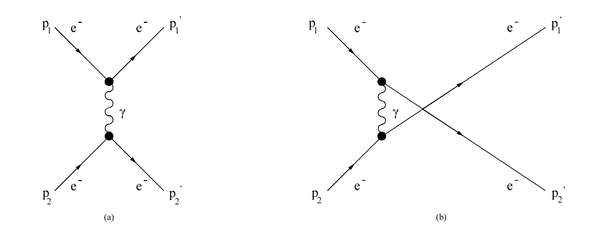Difference between revisions of "Scattering Amplitude"
Jump to navigation
Jump to search

| Line 1: | Line 1: | ||
=Scattering Amplitude= | =Scattering Amplitude= | ||
| − | In the Møller scattering <math>(\mathbf P_1 + \mathbf P_2 \rightarrow \mathbf P_1^' + \mathbf P_2^')</math> we have deal with identical particles in the initial and final states, which means that the amplitude has to be symmetric under interchange of particles <math>(\mathbf P_1^' \leftrightarrow \mathbf P_2^' or \mathbf P_1 \leftrightarrow \mathbf P_2)</math>. As a consequence there will be two Feynman diagrams to describe this scattering. | + | In the Møller scattering <math>(\mathbf P_1 + \mathbf P_2 \rightarrow \mathbf P_1^' + \mathbf P_2^')</math> we have deal with identical particles in the initial and final states, which means that the amplitude has to be symmetric under interchange of particles <math>(\mathbf P_1^' \leftrightarrow \mathbf P_2^' </math>or<math> \mathbf P_1 \leftrightarrow \mathbf P_2)</math>. As a consequence there will be two Feynman diagrams to describe this scattering. |
<center>[[File:Feynman1stLevel.png | 600 px]]</center> | <center>[[File:Feynman1stLevel.png | 600 px]]</center> | ||
Revision as of 15:22, 26 June 2017
Scattering Amplitude
In the Møller scattering we have deal with identical particles in the initial and final states, which means that the amplitude has to be symmetric under interchange of particles or. As a consequence there will be two Feynman diagrams to describe this scattering.

Using the Feynman rules, each vertex contribute a factor
and the propagator gives
where q is the momentum of the photon
Without loss of generality, we can extend this to the center of mass frame
Using the fact that